Analysis of Professional IT Culture: Team Performance and Motivation
VerifiedAdded on 2020/02/24
|6
|996
|55
Report
AI Summary
This report examines professional IT culture through an analysis of team performance, active listening, and motivational factors. Part 1 focuses on contrasting the performance of two teams, highlighting the impact of member participation, communication, and collaboration on team success. The first team demonstrated effective communication and feedback, leading to better interdependence and goal achievement. Conversely, the second team struggled with poor communication and engagement, affecting their ability to complete the task. Part 2 delves into the concepts of active listening, emphasizing the importance of reflecting on thoughts before emotions. It also compares internal and external motivators, with a focus on the effectiveness of internal motivators in driving performance. Finally, the report includes a personal reflection on a team conflict, illustrating the role of culture and relationships in conflict resolution within a collaborative environment, and how the management intervened to resolve it.
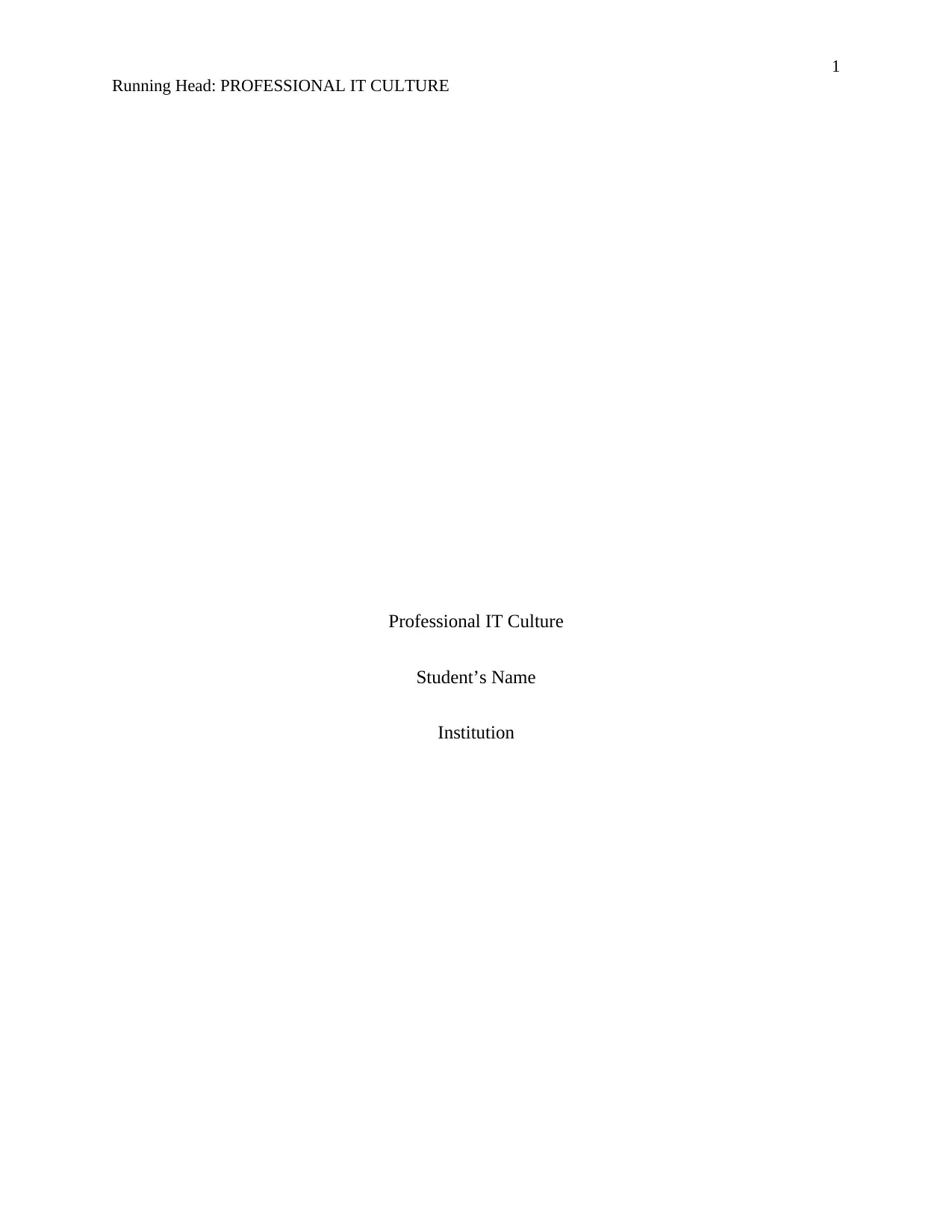
1
Running Head: PROFESSIONAL IT CULTURE
Professional IT Culture
Student’s Name
Institution
Running Head: PROFESSIONAL IT CULTURE
Professional IT Culture
Student’s Name
Institution
Paraphrase This Document
Need a fresh take? Get an instant paraphrase of this document with our AI Paraphraser
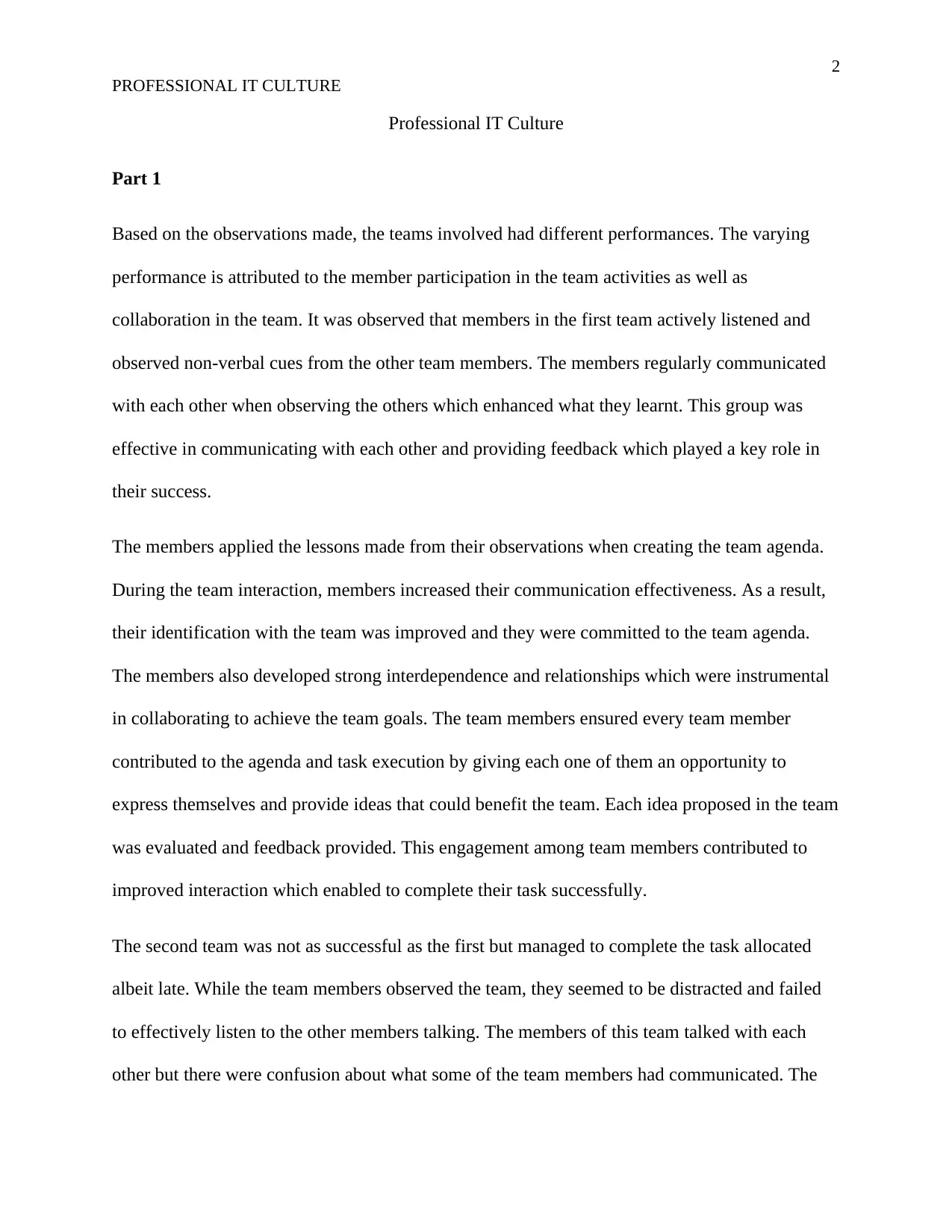
2
PROFESSIONAL IT CULTURE
Professional IT Culture
Part 1
Based on the observations made, the teams involved had different performances. The varying
performance is attributed to the member participation in the team activities as well as
collaboration in the team. It was observed that members in the first team actively listened and
observed non-verbal cues from the other team members. The members regularly communicated
with each other when observing the others which enhanced what they learnt. This group was
effective in communicating with each other and providing feedback which played a key role in
their success.
The members applied the lessons made from their observations when creating the team agenda.
During the team interaction, members increased their communication effectiveness. As a result,
their identification with the team was improved and they were committed to the team agenda.
The members also developed strong interdependence and relationships which were instrumental
in collaborating to achieve the team goals. The team members ensured every team member
contributed to the agenda and task execution by giving each one of them an opportunity to
express themselves and provide ideas that could benefit the team. Each idea proposed in the team
was evaluated and feedback provided. This engagement among team members contributed to
improved interaction which enabled to complete their task successfully.
The second team was not as successful as the first but managed to complete the task allocated
albeit late. While the team members observed the team, they seemed to be distracted and failed
to effectively listen to the other members talking. The members of this team talked with each
other but there were confusion about what some of the team members had communicated. The
PROFESSIONAL IT CULTURE
Professional IT Culture
Part 1
Based on the observations made, the teams involved had different performances. The varying
performance is attributed to the member participation in the team activities as well as
collaboration in the team. It was observed that members in the first team actively listened and
observed non-verbal cues from the other team members. The members regularly communicated
with each other when observing the others which enhanced what they learnt. This group was
effective in communicating with each other and providing feedback which played a key role in
their success.
The members applied the lessons made from their observations when creating the team agenda.
During the team interaction, members increased their communication effectiveness. As a result,
their identification with the team was improved and they were committed to the team agenda.
The members also developed strong interdependence and relationships which were instrumental
in collaborating to achieve the team goals. The team members ensured every team member
contributed to the agenda and task execution by giving each one of them an opportunity to
express themselves and provide ideas that could benefit the team. Each idea proposed in the team
was evaluated and feedback provided. This engagement among team members contributed to
improved interaction which enabled to complete their task successfully.
The second team was not as successful as the first but managed to complete the task allocated
albeit late. While the team members observed the team, they seemed to be distracted and failed
to effectively listen to the other members talking. The members of this team talked with each
other but there were confusion about what some of the team members had communicated. The
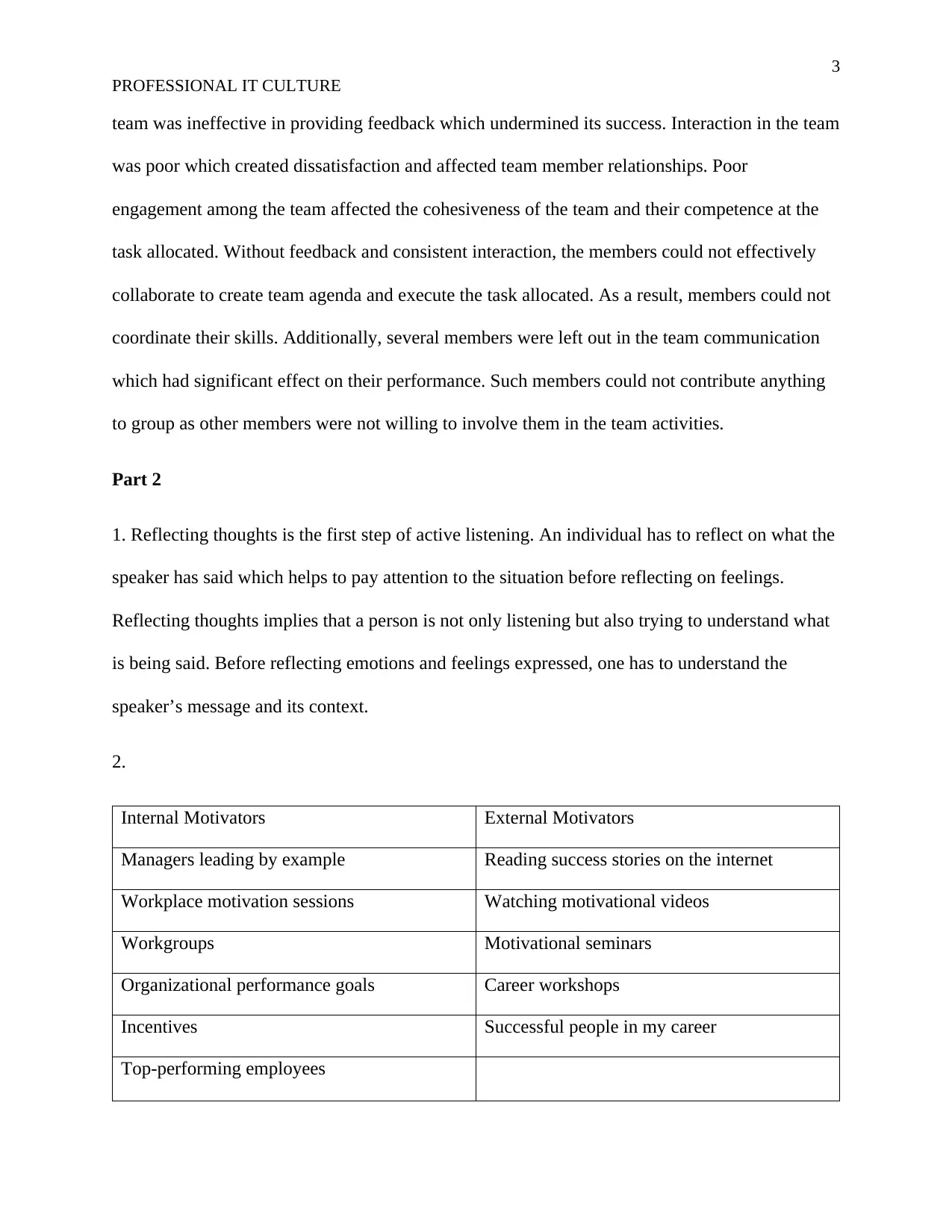
3
PROFESSIONAL IT CULTURE
team was ineffective in providing feedback which undermined its success. Interaction in the team
was poor which created dissatisfaction and affected team member relationships. Poor
engagement among the team affected the cohesiveness of the team and their competence at the
task allocated. Without feedback and consistent interaction, the members could not effectively
collaborate to create team agenda and execute the task allocated. As a result, members could not
coordinate their skills. Additionally, several members were left out in the team communication
which had significant effect on their performance. Such members could not contribute anything
to group as other members were not willing to involve them in the team activities.
Part 2
1. Reflecting thoughts is the first step of active listening. An individual has to reflect on what the
speaker has said which helps to pay attention to the situation before reflecting on feelings.
Reflecting thoughts implies that a person is not only listening but also trying to understand what
is being said. Before reflecting emotions and feelings expressed, one has to understand the
speaker’s message and its context.
2.
Internal Motivators External Motivators
Managers leading by example Reading success stories on the internet
Workplace motivation sessions Watching motivational videos
Workgroups Motivational seminars
Organizational performance goals Career workshops
Incentives Successful people in my career
Top-performing employees
PROFESSIONAL IT CULTURE
team was ineffective in providing feedback which undermined its success. Interaction in the team
was poor which created dissatisfaction and affected team member relationships. Poor
engagement among the team affected the cohesiveness of the team and their competence at the
task allocated. Without feedback and consistent interaction, the members could not effectively
collaborate to create team agenda and execute the task allocated. As a result, members could not
coordinate their skills. Additionally, several members were left out in the team communication
which had significant effect on their performance. Such members could not contribute anything
to group as other members were not willing to involve them in the team activities.
Part 2
1. Reflecting thoughts is the first step of active listening. An individual has to reflect on what the
speaker has said which helps to pay attention to the situation before reflecting on feelings.
Reflecting thoughts implies that a person is not only listening but also trying to understand what
is being said. Before reflecting emotions and feelings expressed, one has to understand the
speaker’s message and its context.
2.
Internal Motivators External Motivators
Managers leading by example Reading success stories on the internet
Workplace motivation sessions Watching motivational videos
Workgroups Motivational seminars
Organizational performance goals Career workshops
Incentives Successful people in my career
Top-performing employees
⊘ This is a preview!⊘
Do you want full access?
Subscribe today to unlock all pages.

Trusted by 1+ million students worldwide
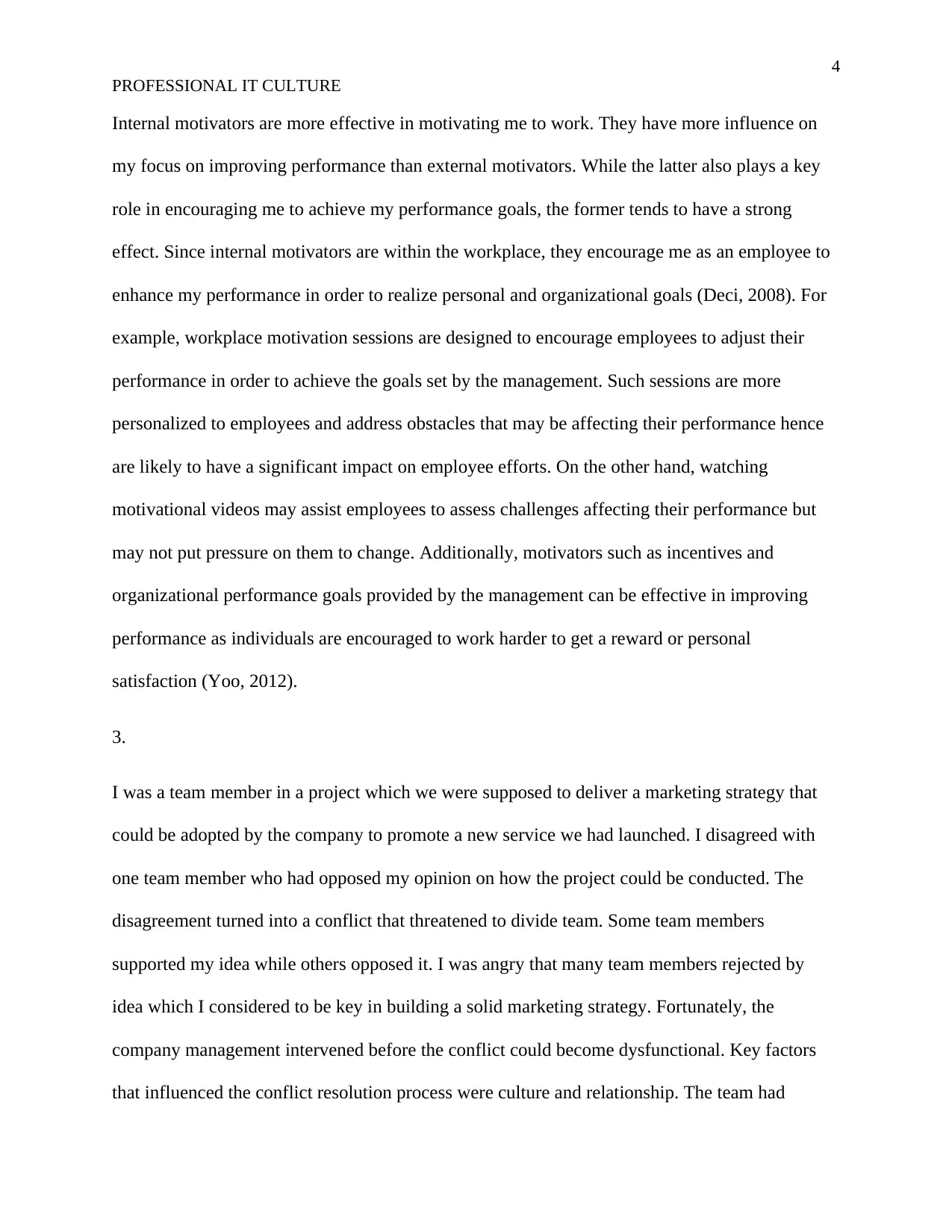
4
PROFESSIONAL IT CULTURE
Internal motivators are more effective in motivating me to work. They have more influence on
my focus on improving performance than external motivators. While the latter also plays a key
role in encouraging me to achieve my performance goals, the former tends to have a strong
effect. Since internal motivators are within the workplace, they encourage me as an employee to
enhance my performance in order to realize personal and organizational goals (Deci, 2008). For
example, workplace motivation sessions are designed to encourage employees to adjust their
performance in order to achieve the goals set by the management. Such sessions are more
personalized to employees and address obstacles that may be affecting their performance hence
are likely to have a significant impact on employee efforts. On the other hand, watching
motivational videos may assist employees to assess challenges affecting their performance but
may not put pressure on them to change. Additionally, motivators such as incentives and
organizational performance goals provided by the management can be effective in improving
performance as individuals are encouraged to work harder to get a reward or personal
satisfaction (Yoo, 2012).
3.
I was a team member in a project which we were supposed to deliver a marketing strategy that
could be adopted by the company to promote a new service we had launched. I disagreed with
one team member who had opposed my opinion on how the project could be conducted. The
disagreement turned into a conflict that threatened to divide team. Some team members
supported my idea while others opposed it. I was angry that many team members rejected by
idea which I considered to be key in building a solid marketing strategy. Fortunately, the
company management intervened before the conflict could become dysfunctional. Key factors
that influenced the conflict resolution process were culture and relationship. The team had
PROFESSIONAL IT CULTURE
Internal motivators are more effective in motivating me to work. They have more influence on
my focus on improving performance than external motivators. While the latter also plays a key
role in encouraging me to achieve my performance goals, the former tends to have a strong
effect. Since internal motivators are within the workplace, they encourage me as an employee to
enhance my performance in order to realize personal and organizational goals (Deci, 2008). For
example, workplace motivation sessions are designed to encourage employees to adjust their
performance in order to achieve the goals set by the management. Such sessions are more
personalized to employees and address obstacles that may be affecting their performance hence
are likely to have a significant impact on employee efforts. On the other hand, watching
motivational videos may assist employees to assess challenges affecting their performance but
may not put pressure on them to change. Additionally, motivators such as incentives and
organizational performance goals provided by the management can be effective in improving
performance as individuals are encouraged to work harder to get a reward or personal
satisfaction (Yoo, 2012).
3.
I was a team member in a project which we were supposed to deliver a marketing strategy that
could be adopted by the company to promote a new service we had launched. I disagreed with
one team member who had opposed my opinion on how the project could be conducted. The
disagreement turned into a conflict that threatened to divide team. Some team members
supported my idea while others opposed it. I was angry that many team members rejected by
idea which I considered to be key in building a solid marketing strategy. Fortunately, the
company management intervened before the conflict could become dysfunctional. Key factors
that influenced the conflict resolution process were culture and relationship. The team had
Paraphrase This Document
Need a fresh take? Get an instant paraphrase of this document with our AI Paraphraser
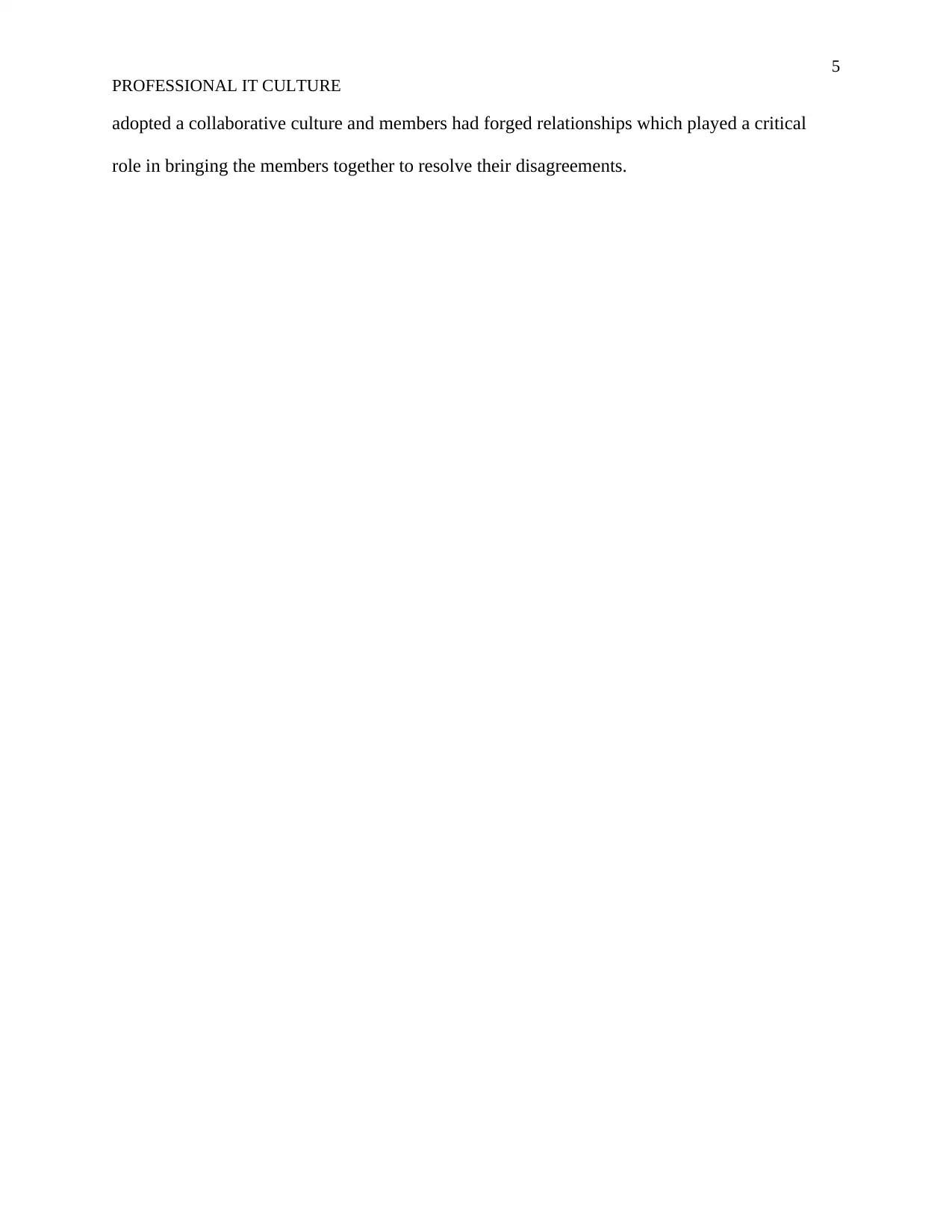
5
PROFESSIONAL IT CULTURE
adopted a collaborative culture and members had forged relationships which played a critical
role in bringing the members together to resolve their disagreements.
PROFESSIONAL IT CULTURE
adopted a collaborative culture and members had forged relationships which played a critical
role in bringing the members together to resolve their disagreements.
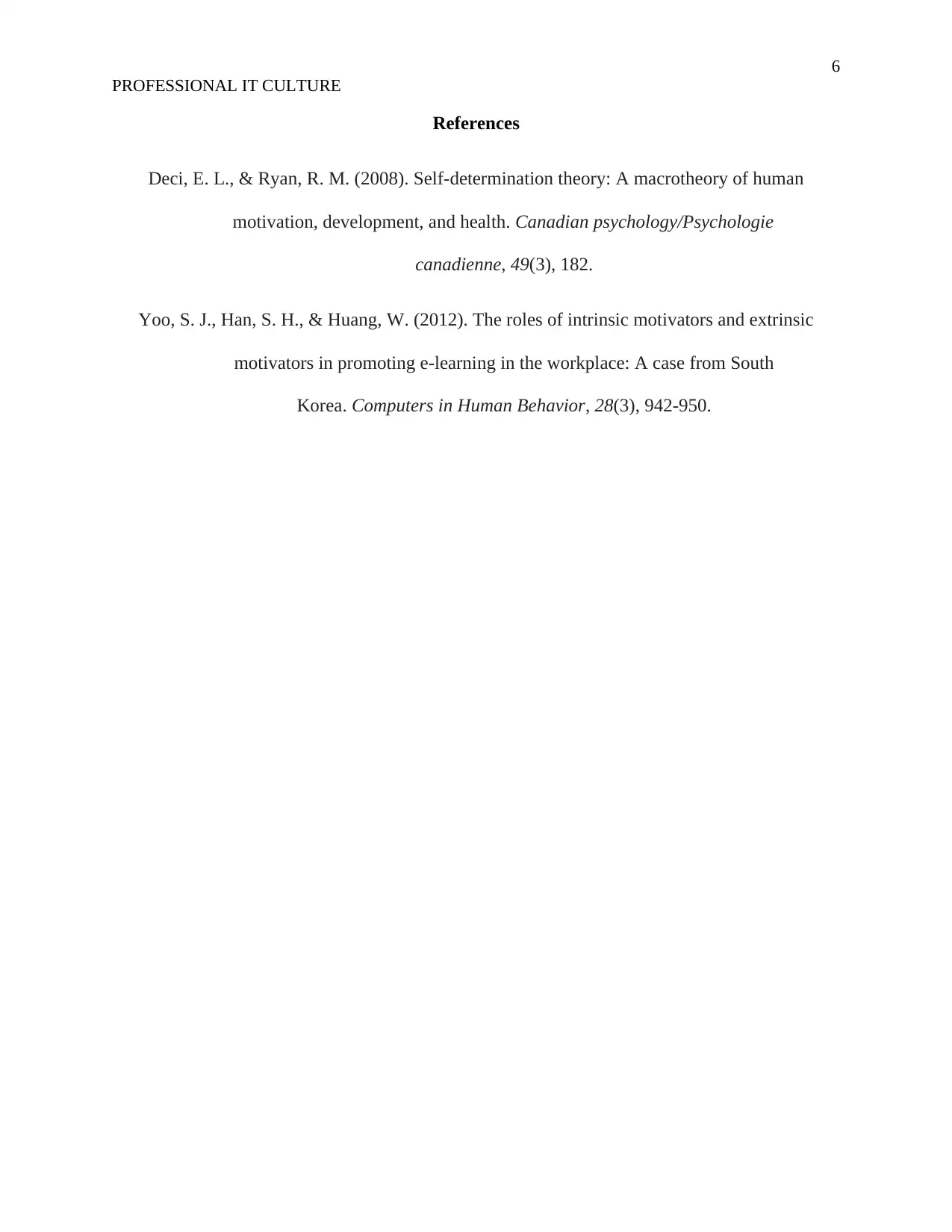
6
PROFESSIONAL IT CULTURE
References
Deci, E. L., & Ryan, R. M. (2008). Self-determination theory: A macrotheory of human
motivation, development, and health. Canadian psychology/Psychologie
canadienne, 49(3), 182.
Yoo, S. J., Han, S. H., & Huang, W. (2012). The roles of intrinsic motivators and extrinsic
motivators in promoting e-learning in the workplace: A case from South
Korea. Computers in Human Behavior, 28(3), 942-950.
PROFESSIONAL IT CULTURE
References
Deci, E. L., & Ryan, R. M. (2008). Self-determination theory: A macrotheory of human
motivation, development, and health. Canadian psychology/Psychologie
canadienne, 49(3), 182.
Yoo, S. J., Han, S. H., & Huang, W. (2012). The roles of intrinsic motivators and extrinsic
motivators in promoting e-learning in the workplace: A case from South
Korea. Computers in Human Behavior, 28(3), 942-950.
⊘ This is a preview!⊘
Do you want full access?
Subscribe today to unlock all pages.

Trusted by 1+ million students worldwide
1 out of 6
Related Documents
Your All-in-One AI-Powered Toolkit for Academic Success.
+13062052269
info@desklib.com
Available 24*7 on WhatsApp / Email
![[object Object]](/_next/static/media/star-bottom.7253800d.svg)
Unlock your academic potential
Copyright © 2020–2025 A2Z Services. All Rights Reserved. Developed and managed by ZUCOL.




